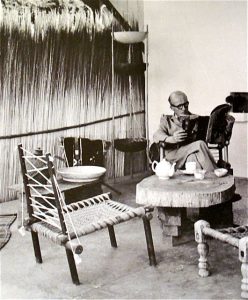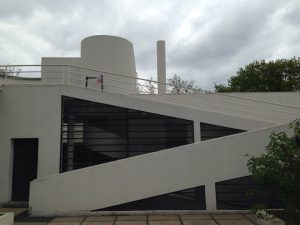By Patrizia Rossato Mari
Posted in Architettura, Design, Linea, Personaggi | Tags : architettura indiana, Charlotte Perriand, collezionismo, Cubism, design, Le Corbusier, manifesto dell'architettura, Minimalism, modernariato, Pierre Jeanneret, seating furniture, Villa Savoye
Pierre Jeanneret, architetto e designer svizzero, principalmente conosciuto per il Minimalismo estremo dello seating furniture da lui disegnato, è nome di primissimo piano del movimento di rottura che svelse e mutò le basi concettuali dell’architettura non solo svizzera nei primi del ‘900. Collaboratore di suo cugino Le Corbusier nella realizzazione di molti edifici pubblici e privati, si mantenne negli anni fedele, nonostante un certo eclettismo, ai principi di un Cubismo Sintetico. Ogni luogo era pensato ed edificato intorno al cliente. Pur vissuto nell’ombra del più famoso cugino, uno degli accreditati maestri dell’architettura contemporanea, il suo fu un contributo essenziale al rinnovamento dell’architettura in termini di rigore, essenzialità, funzionalità, immagine concettuale come risulta ad esempio da Villa Savoye, uno dei manifesti nel Movimento.
Creare linee e forme di impatto e rottura, fu leitmotiv anche delle sue incursioni nella sfera del design, come collaboratore di Charlotte Perriand e Jean Prouvé. Nel 1951 ebbe una nuova opportunità di collaborazione con Le Corbusier come capo progetto della nuova città di Chandigarh, in India, dove si trasferì. Si considerava e ambiva a essere soprattutto urbanista, e l’architettura indiana gli deve l’ideazione e realizzazione di quello che sarà il concept di edificio urbano nel post-indipendenza.*********
Pierre Jeanneret, Swiss architect and designer, mainly known for the extreme minimalism of the seating furniture he designed, is the leading name of the breakaway movement that unveiled and changed the conceptual basis of not just Swiss architecture in the early 1900s. Collaborator of his cousin Le Corbusier in the realization of many public and private buildings, he remained in the years faithful, despite a certain eclecticism, to the principles of a Synthetic Cubism. Every place was designed and built around the customer. Although he lived in the shadow of the most famous cousin, one of the most acclaimed masters of contemporary architecture, his was an essential contribution to the renewal of architecture in terms of rigor, essentiality, functionality, conceptual image as shown for example by Villa Savoye, one of posters in the Movement.
Creating lines and shapes of impact and rupture, was also the leitmotiv of his forays into the sphere of design, as a collaborator of Charlotte Perriand and Jean Prouvé. In 1951 he had a new opportunity to collaborate with Le Corbusier as project leader of the new city of Chandigarh, India, where he moved. He considered himself and aspired to be above all urbanist, and Indian architecture owed him the ideation and realization of what will be the concept of urban building in post-independence.
- Pierre Jeanneret
- Pierre Jeanneret, set Ca 1955
- Villa Savoye, Poissy







Comments are closed.